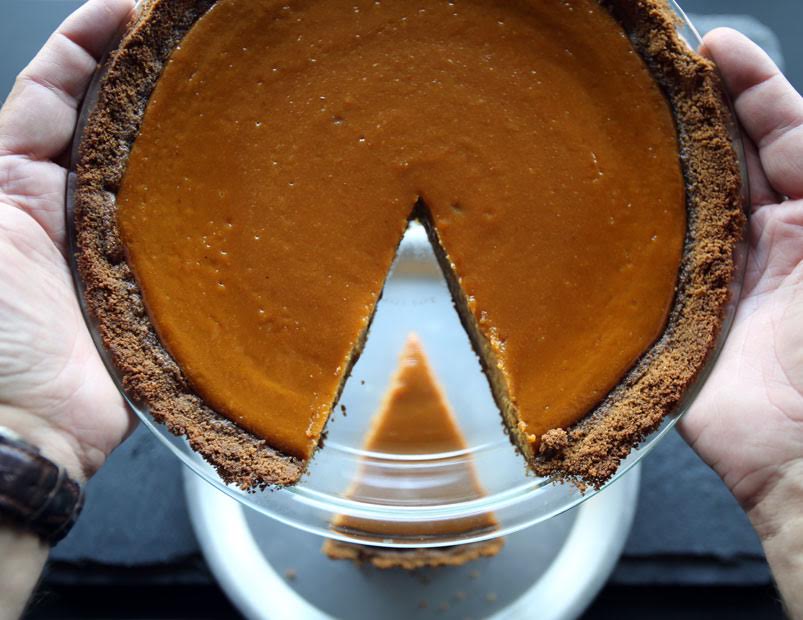
Lemon Meringue Pie: Reloaded

ACTIVE TIME: 1 hour 15 minutes
TOTAL TIME: 5 hours 30 minutes
Yield: 6 to 8 servings
If your cards, letters, interweb postings, smoke signals and telegraphs are any indication, many of you took issue with my original lemon meringue pie recipe, so we freakin' redesigned it from scratch. Now, it's not only stable, thanks to a new Swiss meringue, but it's also tastier than ever, thanks to a 100 percent butter crust. Note: Propane gas torches are highly flammable and should be kept away from heat, open flame and prolonged exposure to sunlight. They should be used only in well-ventilated areas. Follow torch manufacturer's instructions for use.This recipe first appeared on Season 1 of Good Eats: Reloaded
Read More
Read Less
Software
Crust
- 8 tablespoons (1 stick) unsalted butter
- 1 cup plus 2 tablespoons plus 2 teaspoons all-purpose flour
- 1/2 teaspoon kosher salt
- 1/4 cup ice water
Pie
- 2 cups sugar, divided
- 4 large eggs, separated
- 1/4 cup cornstarch
- 1 1/2 cups water
- 1/2 teaspoon kosher salt, divided
- 1/2 cup fresh lemon juice
- 1 packed tablespoon finely grated lemon zest
- 3 tablespoons unsalted butter, cubed, at room temperature
- 1/2 teaspoon cream of tartar
Specialized Hardware

ACTIVE TIME: 1 hour 15 minutes
TOTAL TIME: 5 hours 30 minutes
Yield: 6 to 8 servings
Procedure
- Make the crust: Place the butter in the freezer for 15 minutes, along with two identical 9-inch metal pie pans.
- Combine the flour and salt in the bowl of a food processor and use one-second pulses to combine. Add the butter and pulse until the texture looks mealy and the butter has formed uniformly small pebbles, about 10 one-second pulses. Pour in the water and pulse until you can no longer see large pieces of butter and the mixture holds together when squeezed, 5 one-second pulses. Turn the dough out onto a sheet of plastic wrap and draw the plastic up around it, squeezing and pressing the dough into a ball. Flatten into a 1-inch-thick disk and refrigerate for 30 minutes.
- Remove the dough from the refrigerator, unwrap, and place on a lightly floured piece of parchment paper. Dust the top of the disk with a small amount of flour and top with a second sheet of parchment. Roll the dough out into an 1/8-inch-thick circle. If the dough is too firm to roll at first, give it 5 minutes on the counter to soften, but not much more or the fat may start to melt.
- Remove the pie pans from the freezer and invert one. Lay the dough, still sandwiched between the parchment sheets, over the inverted pan and peel back the top sheet of parchment. Place the second pan over the inverted pan and press down gently to shape the dough. Flip both pans over, lift the top one out and peel away the second piece of parchment. Set the top pie pan back into the other to create a pan-dough sandwich. Invert the pan-dough sandwich and trim away excess dough. Freeze the pan-dough sandwich, upside down, for at least 30 minutes or up to overnight.
- When ready to bake, position a rack in the center of the oven with a second rack just beneath it. Place a sheet pan on the lower rack. Heat the oven to 300°F.
- Place the inverted pie pans in the oven directly on the top rack. Bake until the crust begins to set, 1 hour, then crank the oven to 375°F, and continue to bake until you can see the edges of the crust turn deep brown, 20 to 30 minutes. (The final baking time is highly dependent on the color of your pie plates; darker plates will accelerate cooking, so begin checking after the crust has been baking at 375°F for 20 minutes. If you use light metal plates, expect this second baking time to be closer to 30 or 40 minutes. Do not under-bake the crust.) Remove from the oven, flip right side-up, remove the top pie pan, and cool completely before you make the filling.
- Make the pie: Place 140 grams (1/2 cup plus 3 tablespoons) of the sugar in a medium bowl, along with the egg yolk and cornstarch. Whisk until very smooth and thick. Stash near the cooktop. Place a fine-mesh sieve over a second medium bowl; stash this next to the cooktop as well.
- Combine the water, 1/4 teaspoon of the salt, and another 140 grams (1/2 cup plus 3 tablespoons) sugar in a medium saucepan. Place over medium-high heat and cook, whisking frequently, until the sugar dissolves and the mixture is very steamy, forms small bubbles around the edges of the pan, and registers 160°F, 2 to 3 minutes. Whisk in the lemon juice and lemon zest, then remove from the heat.
While whisking constantly, slowly ladle about one-third of the sugar mixture into the egg mixtureThe mixture will be quite thick at first. to temper the yolks. Whisk this egg mixture back into the saucepan and place over medium-low heat. Cook, whisking constantly, until beginning to thicken and bubble, 3 to 5 minutes. Continue to cook until the mixture begins to turn translucent and registers 200°F, 1 to 2 more minutes. Immediately pour through the prepared sieve into the clean bowl to strain out any rouge bits of egg. Whisk in the butter, a few cubes at a time, until smooth. Pour into the cooled pie shell. Let cool completely before making the meringue, 2 to 3 hours. - When the filling has cooled and set, prepare the meringue topping: Place a folded kitchen towel in the bottom of an 11-inch straight-sided sauté pan or large skillet. Fill the pan with 1 inch of water. Place over medium-high heat and bring to a bare simmer, about 190°F. You should see steam and tiny bubbles, but the bubbles shouldn’t be breaking rapidly on the surface.
- Whisk together the egg whites, cream of tartar, remaining 125 grams (1/2 cup plus 2 tablespoons) sugar, and remaining 1/4 teaspoon salt in the bowl of a stand mixer until smooth and foamy, about 30 seconds. Place the stand mixer bowl on the kitchen towel in the hot water, tilting the bowl as needed so the egg mixture is sitting in the water. Let the mixture heat, whisking constantly, until it reaches 165°F, 5 to 10 minutes.
- Place the bowl in the stand mixer. Fit the mixture with the whisk attachment, then beat on high speed until soft peaks form, about 1 minute. Reduce the speed to medium and continue to beat until stiff peaks form, 3 to 5 minutes more.
- Top the pie with the meringue, making sure to spread the meringue all of the way to the edges of the crust. If desired, use a spoon to create swirls and waves inthe meringue. Use a culinary or propane gas torch to brown the top, if desired. But who doesn't desire torching a meringue? Serve immediately or refrigerate up to overnight before serving.







